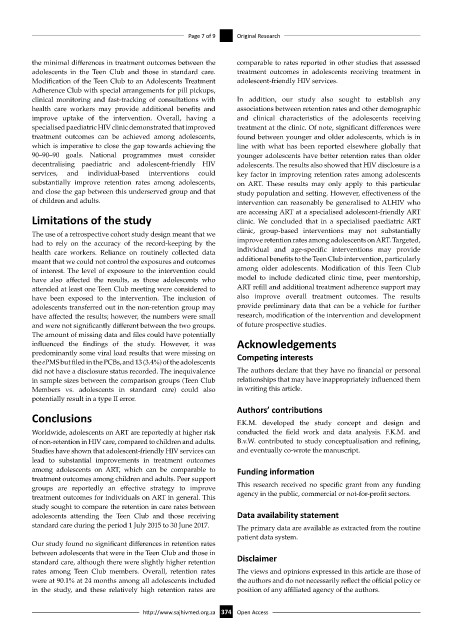Page 382 - HIVMED_v21_i1.indb
P. 382
Page 7 of 9 Original Research
the minimal differences in treatment outcomes between the comparable to rates reported in other studies that assessed
adolescents in the Teen Club and those in standard care. treatment outcomes in adolescents receiving treatment in
Modification of the Teen Club to an Adolescents Treatment adolescent-friendly HIV services.
Adherence Club with special arrangements for pill pickups,
clinical monitoring and fast-tracking of consultations with In addition, our study also sought to establish any
health care workers may provide additional benefits and associations between retention rates and other demographic
improve uptake of the intervention. Overall, having a and clinical characteristics of the adolescents receiving
specialised paediatric HIV clinic demonstrated that improved treatment at the clinic. Of note, significant differences were
treatment outcomes can be achieved among adolescents, found between younger and older adolescents, which is in
which is imperative to close the gap towards achieving the line with what has been reported elsewhere globally that
90–90–90 goals. National programmes must consider younger adolescents have better retention rates than older
decentralising paediatric and adolescent-friendly HIV adolescents. The results also showed that HIV disclosure is a
services, and individual-based interventions could key factor in improving retention rates among adolescents
substantially improve retention rates among adolescents, on ART. These results may only apply to this particular
and close the gap between this underserved group and that study population and setting. However, effectiveness of the
of children and adults. intervention can reasonably be generalised to ALHIV who
are accessing ART at a specialised adolescent-friendly ART
Limitations of the study clinic. We concluded that in a specialised paediatric ART
clinic, group-based interventions may not substantially
The use of a retrospective cohort study design meant that we
had to rely on the accuracy of the record-keeping by the improve retention rates among adolescents on ART. Targeted,
health care workers. Reliance on routinely collected data individual and age-specific interventions may provide
meant that we could not control the exposures and outcomes additional benefits to the Teen Club intervention, particularly
of interest. The level of exposure to the intervention could among older adolescents. Modification of this Teen Club
have also affected the results, as those adolescents who model to include dedicated clinic time, peer mentorship,
attended at least one Teen Club meeting were considered to ART refill and additional treatment adherence support may
have been exposed to the intervention. The inclusion of also improve overall treatment outcomes. The results
adolescents transferred out in the non-retention group may provide preliminary data that can be a vehicle for further
have affected the results; however, the numbers were small research, modification of the intervention and development
and were not significantly different between the two groups. of future prospective studies.
The amount of missing data and files could have potentially
influenced the findings of the study. However, it was Acknowledgements
predominantly some viral load results that were missing on Competing interests
the ePMS but filed in the PCBs, and 13 (3.4%) of the adolescents
did not have a disclosure status recorded. The inequivalence The authors declare that they have no financial or personal
in sample sizes between the comparison groups (Teen Club relationships that may have inappropriately influenced them
Members vs. adolescents in standard care) could also in writing this article.
potentially result in a type II error.
Authors’ contributions
Conclusions F.K.M. developed the study concept and design and
Worldwide, adolescents on ART are reportedly at higher risk conducted the field work and data analysis. F.K.M. and
of non-retention in HIV care, compared to children and adults. B.v.W. contributed to study conceptualisation and refining,
Studies have shown that adolescent-friendly HIV services can and eventually co-wrote the manuscript.
lead to substantial improvements in treatment outcomes
among adolescents on ART, which can be comparable to Funding information
treatment outcomes among children and adults. Peer support
groups are reportedly an effective strategy to improve This research received no specific grant from any funding
treatment outcomes for individuals on ART in general. This agency in the public, commercial or not-for-profit sectors.
study sought to compare the retention in care rates between
adolescents attending the Teen Club and those receiving Data availability statement
standard care during the period 1 July 2015 to 30 June 2017. The primary data are available as extracted from the routine
patient data system.
Our study found no significant differences in retention rates
between adolescents that were in the Teen Club and those in
standard care, although there were slightly higher retention Disclaimer
rates among Teen Club members. Overall, retention rates The views and opinions expressed in this article are those of
were at 90.1% at 24 months among all adolescents included the authors and do not necessarily reflect the official policy or
in the study, and these relatively high retention rates are position of any affiliated agency of the authors.
http://www.sajhivmed.org.za 374 Open Access

